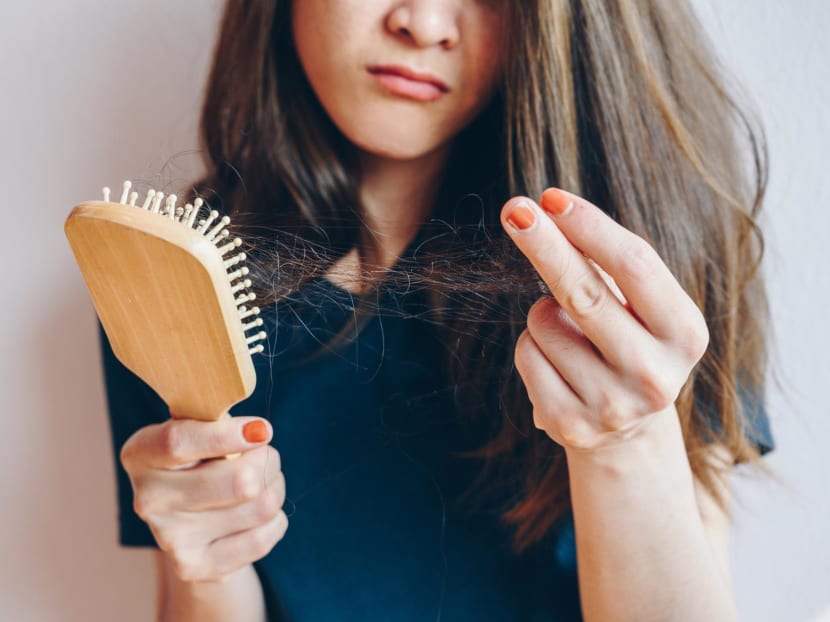
When hair fall becomes hair loss. (Photo: iStock)
Yes, everyone sheds hair every day. But how much is considered normal and when should we start panicking?
About 50 to 100 strands of hair daily is normal, said Dr Ben Yim, an aesthetic doctor with IDS Clinic. “We shed the hair as all the follicles in our scalp go through the stages of the hair cycle. It is a turnover process, just like how we shed the dead skin on the surface for the new skin below to replace it.”
However, some people might shed more than this amount due to various reasons. The amount of hair shed daily also correlates with your health condition, stress levels, sleeping habits and haircare routines.
Some common reasons behind an increased hair fall can be due to stress, medical conditions, hormonal change, unbalanced diet as well as improper use of scalp and haircare products.
HOW MUCH HAIR FALL IS TOO MUCH?

It’s perfectly normal to be shedding hair every day. However, if you notice an increased hair fall during your shower, hair falls out easily when you run your fingers through it or find more hair on your pillows in the morning, these can all be signs of early hair loss.
Alternatively, experiencing excessive hair shedding across the entire scalp is also a sign of too much hair fall, leading to hair loss.
And if you’re losing more than 100 strands a day, Dr Yim strongly advised to seek medical help to address the situation before it becomes worse. “If you start to lose more than the above numbers then, I would consider it abnormal and a cause for concern and would recommend visiting your doctor,” he added.
Fortunately, it’s not all doom and gloom. With the exception of male or female-pattern baldness, most medical conditions are treatable and the hair loss can be reversed, said Dr Yim. For instance, if the hair loss is caused by a significant stressful period in your life, once that period is over, the increased hair fall should stop.

Unfortunately, thinning hair is often a common sign of any hair loss related issues. This is due to the hair follicles shrinking, which in turn causes the hair strands to become finer and result in some follicles stopping to produce hair altogether.
The reasons behind this are often similar to the causes behind an increased hair fall, such as lifestyle habits and even genetics.
According to Dr Yim, the thinning of the hair can also happen due to male-pattern baldness or female-pattern baldness. There is a miniaturisation of hair follicles over time, due to the effects of the male hormone called testosterone on the follicle. And as the miniaturisation progresses, it can lead to permanent loss of hair, he shared.

Did you know that your scalp ages six times faster than the skin on your face? This was shown in a study done by L’Oreal Professional Academy.
In short, ageing does contribute to an increased hair fall you see as you get older. This is due to thinning of the epidermis, loss of elasticity, hormonal changes and slower blood circulation that results in less nutrients being supplied to the hair follicles.
Dr Yim also added that ageing is also associated with an increase incidence of hair loss from male-pattern or female-pattern baldness as well. For example, 30 per cent of men will have male pattern baldness by the age of 30 years old and 50 per cent will be affected by the age of 50 years old. For women, this condition usually affects them around the menopausal age and can increase to over 50 per cent by the age of 70 years old, he shared.

Fortunately, you can reduce excessive hair fall. Here’s what you can do.
- Avoid unnecessary pulling of the hair, said Dr Yim. This includes pulling your hair too tight when tying it up in a ponytail or bun.
- Do a scalp massage during shampooing. This can include using a scalp massager or your fingertips, as it not only ensures a thorough cleansing but also helps to enhance blood circulation for healthier hair growth.
- Refrain from colouring your hair too often if your scalp is allergic to the chemicals in the hair dye. This is because constant and prolonged scalp irritation can lead to excess hair fall and eventual hair loss.
- Have a well-balanced diet. This can include consuming foods rich with natural DHT (a hormone that can shrink hair follicles leading to hair loss) inhibitors, like soya, sesame seed and green tea, as well as biotin-rich foods like rice bran, peanuts, mushroom and cauliflower, shared Wong.
- Detangle your locks before shampoo and bedtime. Gently brushing your scalp and hair does two things: Help distribute the natural oils from your scalp to the hair from root to tip, and also reduce knotting and friction while you wash your hair or toss and turn during sleep.
Read full artice in CNA Lifestyle

 Skin Consultation
Skin Consultation










